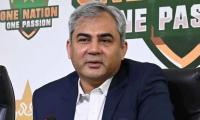The writer is a freelance columnist
and former newspaper editor.
The narrative flashed across television screens and social media on the anniversary of the APS massacre speaks of young heroes and brave children, rather than children caught up in a terrible tragedy that the state’s apathy over many years had helped create.
Those directly responsible for that massacre are yet to be identified. The lack of transparency behind the military trials which led to the hanging of four men almost precisely two weeks before the anniversary of the massacre has been identified by the parents of the victims as one of their main grievances.
And yes, these were victims, not warriors. They did not choose to fight that ‘enemy’ – which apparently cannot be named or identified. They were gunned down because they happened to be at the wrong place at the wrong time – just like the 5,000 or so other persons killed in terrorist attacks since 2002. Most of the women, men and children who died in bazaars, in buses, at mosques or while going about the ordinary routines of life, have never been commemorated or mourned in public. There are no songs written about them, no pictures on walls and no national holidays to mark their passing.
The 137 people killed in October 2009, when a car bomb was detonated in Peshawar’s Meena Bazaar have essentially been forgotten. Most of us would struggle to recall even a single name among the scores who died, the majority of them women and children.
The ‘compensation’ money handed out to families has long ago been frittered away. The cheques doled out after each such event mean little in any case, beyond the immediate. But perhaps worst of all is the fact that we are still failing, despite Operation Zarb-e-Azb, despite government claims and despite the catchy tunes of ISPR songs, to do anything to prevent the growth of terrorism and militancy in ever more extreme forms.
Yes, logically speaking, education could be a useful tool; education not for the ‘children of the enemy’ but for all the children of the country; education different to the kind delivered at the thousands of seminaries which continue to grow – under the eyes of the institutions that effectively run the country.
But what is to be done when the militants, the ‘enemy’, turn out to be already educated – highly educated at that. Four of the men arrested for the May 2015 attack on a bus at Karachi’s Safoora Chowk in which 45 members of the Ismaili community were gunned down have turned out to be graduates of some of the most prestigious institutions in the country.
The man who master-minded the crime attended elite schools in Karachi, did his ‘O’ and ‘A’ levels among the handful of children in the country able to obtain an education at the top English medium schools in the country, obtained his degree from the prestigious IBA in Karachi and was known also as an outstanding tennis player and footballer. His partner in crime, Adil Masood Butt, was educated at an American university and was on the board of governors of one of Karachi’s most respected institutes of higher learning.
More frightening still is the role of the wives of at least some of those held for the Safoora Chowk massacre in promoting extremism. Well connected in society, and with access to others that enjoy the privileges that come with wealth and education, the wife of Saad Aziz, along with his mother-in-law, is believed by police to be a strong supporter of Islamic State, apparently distributing pamphlets for the cause. She and a ring of other women, some of them linked to arrested terrorists, had also in the past run other organisations that encouraged violence and remained active in recruiting women and girls to this cause.
We then have a country in which secret, dangerous events take place in unexpected locations. The homes of the educated and rich, in posh localities across our cities would not normally be seen as places where pamphlets promoting the beheading of enemies or the murder of ‘infidels’ are produced. But it seems that this is happening. In how many places, we do not know. Police plans to crack down on the women operating in Karachi would just be a small start.
We already know that Al-Huda, founded by Farhat Hashmi, who also spread her pro ‘jihad’ message in Canada, has inducted thousands of privileged women across the country into hard-line Islam. Tashfeen Malik, the California mass killer, is reported to have been a follower of Hashmi; apparently she attended Al-Huda lectures and sermons. Are there others like her lurking in the country? Are there other men like Saad Aziz and Adil Masood Butt who put forward one face in society but hide other dark secrets until they strike unexpectedly in one place or the other?
We are in fact dealing with many tiers of militancy. Some of it exists in the seminaries which the poorest of the poor are forced to attend mainly because of the collapse of our public sector education system. They are also there because of the readiness to allow them to flourish in the past and the lack of resources available for education, at least in part because so much of the money we have is taken up by debt servicing, defence and administration. The pupils of these seminaries have been known to link up with extremist organisations or be recruited by them as easy prey for a violent cause. Young men who possess nothing in life, have no opportunity, no hope, no chances of a career are vulnerable to the lure of the gun and the power of a uniform.
But alongside this, we also have a growth of militancy in other places. One problem is that as a state, we refuse to face this reality. Even today, the government continues to claim with less and less credibility that IS is not present in the country. Who, we must ask, then inks the slogans appearing on walls in major cities or distributes the pamphlets that have been found at several locations including places where crimes were committed? It is pointless to deny that Daesh has indeed penetrated our country, or insist that we have been able to hold it back.
There is also the question of just how willing we are to deal with the militancy menace. Even today, there is no action against key figures who promote extremism. The chief cleric of Lal Masjid, Maulana Abdul Aziz, who in 2007 escaped from the mosque under cover of a head-to-toe burka following the army’s operation, is just one example of this. His sermons led to the shutting down of mobile phone services, but beyond this the authorities seem unwilling to act. We must ask why this happens and we must ask who decides on our strategies and policies.
What is the real agenda? Are we really attempting to do away with militancy or do we still see the forces that promote it as possible allies in different causes? The answers to these questions are important. They need to be discussed openly and widely. Until we have the answers, the statements we make, the propagandist music we put forward or the narratives we turn around to suit certain purposes will make no difference and will not change the reality that hangs over the entire country and brings terrible danger at periodic intervals.
Email: kamilahyat@hotmail.com
Please note that dam survey team from World Bank had proposed building of this dam in 1955
Cuts in public sector development spending programme are also likely to further affect quality of essential services
Barriers and hurdles created by Trump's tariff policy have potential to disrupt smooth supply chain of trade and...
Indus Commission having failed to find solution, dispute was discussed by foreign secretaries
This demand has fueled rapid growth deposit base of Islamic Banks and Islamic Windows operated by conventional banks
But Punjab Agriculture Food and Drug Authority building near Thokar Niazbeg on Multan Road stands out







